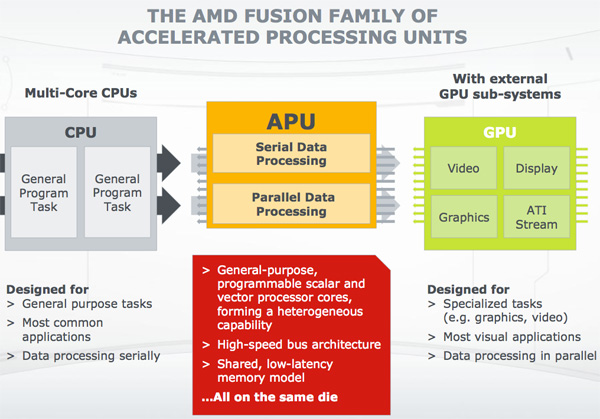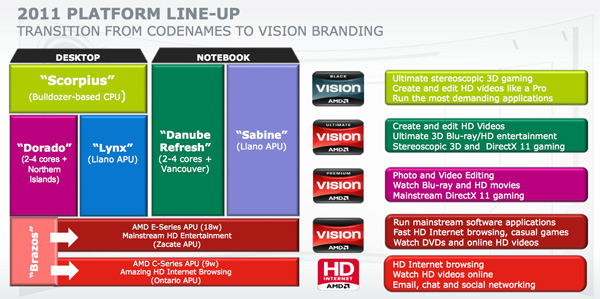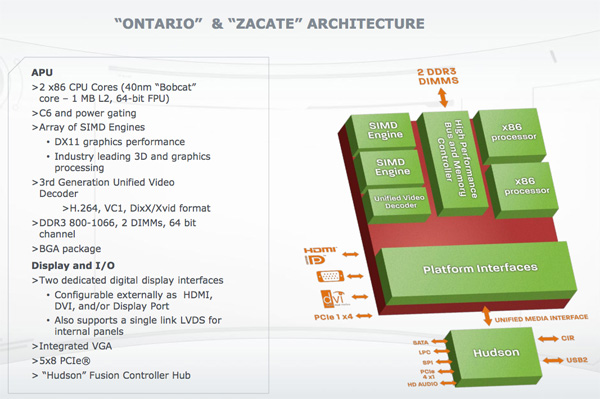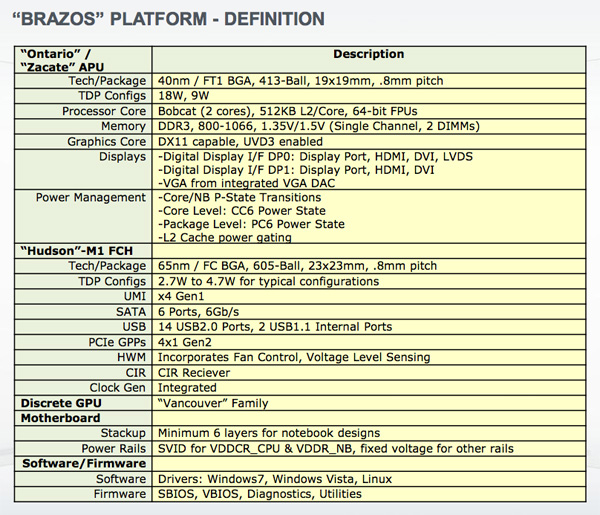Previewing AMD's Brazos, Part 1: More Details on Zacate/Ontario and Fusion
by Anand Lal Shimpi on November 9, 2010 1:09 AM ESTMeet the Brazos
The platform is called Brazos. Brazos encompasses two chips: a Zacate or Ontario APU (Accelerated Processing Unit) and the Hudson Fusion Controller Hub (FCH). This is the whole reason AMD bought ATI, Zacate and Ontario are its first CPU-GPU hybrids.
While AMD is primarily targeting the netbook/ultraportable and notebook markets with Ontario and Zacate (respectively), we’ll also see nettops/desktops and mini-ITX motherboards based on Brazos. This may be the first time we see real competition to NVIDIA’s ION platform.

AMD's Zacate APU, 19mm x 19mm package, 413 balls, 75mm^2 die
Both APUs are built from the same die. Zacate and Ontario are physically identical, they just run at different clock speeds. The 40nm die is manufactured at TSMC and measures 75mm^2. The chip is very cheap to package as well. The BGA package only has 413 balls. As one AMDer put it, these chips are designed to be stamped out as quickly and as cheaply as possible.
Both are available in single and dual core versions, although the single core variant is just a dual-core chip with one core disabled to hit various market segments. Core unlocking is apparently possible, but unexpected given the target for these platforms and the amount of effort OEMs would have to go to in order to enable it.
The CPU cores are based on AMD’s first truly low power client architecture, codenamed Bobcat. We’ve discussed Bobcat in great length already, but at a high level it looks a lot like an out-of-order Atom processor without Hyper Threading. The fundamental architecture advantage should give Bobcat the performance advantage over Atom, at least at identical clock speeds.
The GPU is based on AMD’s 5000 series architecture (Evergreen) and features 80 shader cores and AMD’s new UVD3 decode engine.
The SKUs
At launch you’ll see four SKUs, the combinations and specs are listed below:
| AMD Brazos Lineup | ||||||||
| APU Model | Number of Bobcat Cores | CPU Clock Speed | GPU | Number of GPU Cores | GPU Clock Speed | TDP | ||
| AMD E-350 | 2 | 1.6GHz | Radeon HD 6310 | 80 | 500MHz | 18W | ||
| AMD E-240 | 1 | 1.5GHz | Radeon HD 6310 | 80 | 500MHz | 18W | ||
| AMD C-50 | 2 | 1.0GHz | Radeon HD 6250 | 80 | 280MHz | 9W | ||
| AMD C-30 | 1 | 1.2GHz | Radeon HD 6250 | 80 | 280MHz | 9W | ||
Zacate takes the top two SKUs, while Ontario makes up the bottom two. The difference in TDP is entirely based on the clock speed of the CPU and GPU. And here is my concern. While a pair of Bobcats running at 1.6GHz are just awesome, drop the clock to 1.0GHz and I start getting concerned about performance. AMD didn’t let us test the C-50 but I’m curious to see what the margin of victory will be over Atom at that speed.
The GPU runs at 500MHz at the high end (Radeon HD 6310) and 280MHz at the low end (Radeon HD 6250). This paired with the single channel DDR3-800/1066 memory bus that has to be shared with the Bobcat cores means you should expect sub-5450 levels of performance out of these systems. Given their price point, that’s potentially not too bad. More enticing however is the fact that these APUs gain the benefit of the driver work AMD does on its discrete cards. Finally, game compatibility should be just as good on the low end as it is on the high end - assuming you meet the minimum specs for the title you’re running.
The lack of a brand for the CPU is a bit puzzling, but graphics are where it’s at these days.














106 Comments
View All Comments
Zingam - Tuesday, November 9, 2010 - link
Now that's a picture I like a lot! It is so nerdy! :DMr Perfect - Tuesday, November 9, 2010 - link
The picture of the test setup? Yeah, I like the Pro Networking! "Faceplates? We don't need no stinking faceplates!"Markstar - Tuesday, November 9, 2010 - link
...is when I can see something like this for the Desktop. Obviously this would be awesomeAlso, it becomes pretty apparent that AMD is falling behind more and more when it comes to the manufacturing process. TSMC's troubled 40nm process just doesn't cut it anymore and AMD's own process is pretty far behind as well.
Also, while I often tell people that they don't need to replace their 4 year old computer to check emails, 1/1.2GHz does sound a little low.
mino - Tuesday, November 9, 2010 - link
Q1, there are plenty of ITX designs in the pipe. I just hope someone is smart enough to do a bunch of mATX ones too.Nobody is proposing the 9W for desktops. Also, 1Ghz dual Bobcat shall be in the ballpark of "high-end" Atoms as far as GUI "snappiness" goes.
jabber - Tuesday, November 9, 2010 - link
I've been using a dual core 1.3GHz CULV setup for the past year and its been perfect.I cant tell any day to day difference between it and my 3.4GHz quadcore box.
The need for more CPU power for the day to day tasks mentioned in the article past a long time ago.
The 1.3GHz CULV benches almost as fast as a 3GHz P4D from a few years back. Plenty fast enough.
Remember this platform is aimed at mum and dad boxes. Also I've been farming out dual core Atom ION boxes for office use the past year. Had nothing but positive feedback. Customers love them. Big step up from all those 3GHz single core P4 or AthlonXP boxes they struggled with before.
All hail efficent low power for the mainstream.
Dark_Archonis - Tuesday, November 9, 2010 - link
That's going to be a potential problem for AMD. If people like their Atom boxes, what would entice them to switch to AMD Ontario or Zacate boxes?jabber - Tuesday, November 9, 2010 - link
Not sure thats an issue.Its about appealing to those that havent made any switch yet.
If my customer base is anything to go by there are masses of folks out there struggling along with 3GHz P4 boxes with 512MB of ram and 80GB slow HDDs
They think thats average PC performance. Give them anything under $500 new off the shelf and its a revelation to them.
We really will see a clear divergance of PC use over the next two years.
There will be the small group of hardcore gamers and benchmark junkies.
There will be the small group of specialists/developers/number crunchers.
Then there will be the rest whose CPU needs were met a long time ago and just need the ideal rounded package of CPU/GPU/Media to take care of them.
Dark_Archonis - Tuesday, November 9, 2010 - link
A lot of average people haven't even moved completely to HD videos yet. Current P4 boxes are actually enough for more people than you think.A Celeron or Atom box is enough for a lot of people. You're making an assumption that a large group of buyers *want* something more powerful than an Atom or Celeron, which are the price points Bobcat is aiming at. I think it's debatable how large such a group is.
khimera2000 - Wednesday, November 10, 2010 - link
I think that it will do well. sub 500 sounds fine, and i think there will be a significant group of people who will by this for there kids as there first machine. My brother go an atom job for his son and he hasent even broken out of grade school yet.for the old and intrench.. might be a struggle but for the younger kids i think AMD will do well since they spend most of the time farming on facebook, which will help with gpgpu and the 6xxx vid card.
Zoomer - Tuesday, November 9, 2010 - link
The Sim 5000.